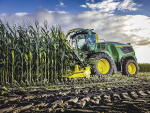Following a couple of bumper sales years when the rolling year-to-date figure for 2022 hit about 16,250 tractors, it looks like things are changing in the Australian farm machinery landscape.
At the recent 2023 Tractor and Machinery Association of Australia annual conference, Melinda Haley from data analysts Kynetec shared her thoughts on the current challenges being encountered by the tractor, combine and baler industry.
With figures to the end of June 2023 falling by around 16%, Haley suggested that the largest factor is still supply chain issues, with shipping quarantine queues being the most prominent.
“Coming off a strong 2022 sales year, we correctly predicted a slowdown in tractor sales into 2023,” she explained. “It was well known that the record sales that were driven by the perfect storm of positive climate, commodity prices and the boosted instant tax write off scheme were not sustainable over the longer term.”
Haley added that the sector was now facing some head winds – namely higher land prices, average commodity prices and lower crop yields; coupled with high agricultural lending, increasing interest rates and the end of the increased instant asset write off scheme.
“Land prices in the central wheat belt are up between 165-168% in the last five years, interest rates have increased while grain prices have settled to 2020 levels. Certainly, these are challenging times when looked at in snapshot, but not unexpected,” she said.
Year to date (YTD), sales of new tractors in the up to 60hp and over 60hp categories are down by 15% and 17% respectively after the busy previous selling period. Baler sales were down 32% on the rolling 12 months, while combines bucked the trend, up by an impressive 78% YTD – with sales increases seen in all states other than NSW. Haley also provided an overview of the Australian farm machinery distribution network, noting that single business outlets had dropped 5%, from 269 to 256. Meanwhile, group business outlets climbed 4% from 394 to 408 – with the total number of outlets remaining static.
“Australian farmers are also experiencing slightly drier conditions than this time last year, with approximately 65% in average conditions or better, however a dry finish is expected,” she concluded.



















